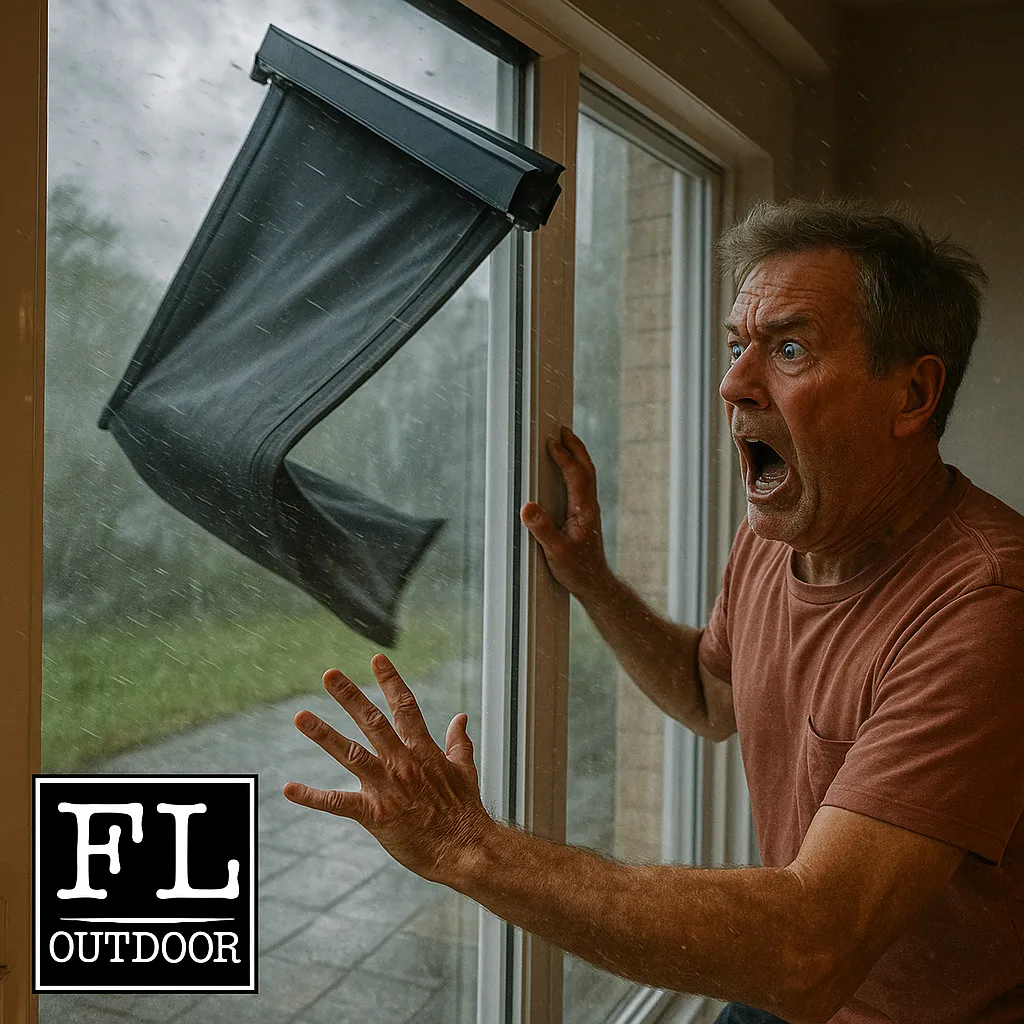
The $10,000 Mistake Hiding Behind Your Hurricane Screen: What Your Installer Didn't Tell You"
Let me set the scene. You’re feeling like a hurricane-ready hero. You had those fancy motorized screens installed last season. Push a button — whoosh — down they go. You even showed them off at your last BBQ like they were part of a James Bond gadget collection. Then… the storm hits.
Wind picks up, rain’s flying sideways, and suddenly — your beautiful screen detaches like a dollar-store Halloween decoration and crashes into your lanai door. Bits of aluminum everywhere. Glass? Maybe. Your peace of mind? Gone with the wind.
Now you’re thinking: Wait, weren’t these supposed to be hurricane screens?
🧱 Turns Out, Footers Aren’t Just a Fancy Add-On
Here’s the thing no one tells you until it’s too late: if your screen is longer than 22 feet (aka the length of a two-car garage), it probably needed to be anchored into a concrete footer. Not your patio pavers, not some decorative trim. We’re talking rebar, concrete, bolts — the kind of stuff that actually holds a screen down when the sky turns into a blender.
Why? Because screens that wide turn into kites during a storm. And unless you’ve got an engineering degree and a secret life as a storm chaser, you probably didn’t know that both the Florida Building Code and the International Building Code require structural anchoring to resist wind uplift forces (See IBC §1604.8 and ACI 318). Manufacturers like Fenetex, Alutech, and others all reference those same code standards in their product approvals and anchor schedules. So it’s not just a “good idea” — it’s literally in the rulebook.
💬 But My Salesperson Said I Didn’t Need It…
Ah yes. The famous line. Right up there with “Trust me, you’ll be fine” and “This one’s on sale today only.”
Sales reps may brush off footers as overkill to make the quote look cheaper. Or maybe they just don’t know better. But when your screen fails and starts its own flying circus in the middle of a Cat 2 storm? Guess who’s holding the bag — and the repair bill.
💸 Now for the Real Punchline: Insurance and Hurricane Screens
You’d think, “Well, that’s what insurance is for, right?” Sure… until your claim gets denied because the screen wasn’t installed per code or didn’t meet manufacturer specs. Most policies assume you did your due diligence. If the screen failed because someone cut corners, your insurer might say, “Sorry, but that sounds like a you problem.” And suddenly, you’re not just replacing the screen — you’re paying for broken glass, ripped-up pavers, damaged furniture, and maybe your neighbor’s precious hibiscus bush.
Oh, and if the screen turns into a projectile and hits someone else’s house? Legal fun begins.
😡 Now You’re Angry, Wet, and Broke. Hurricane Screens
What stings the most isn’t just the damage — it’s the betrayal. You trusted the company. You thought they were protecting your family. Now you’re the one explaining to your spouse why you spent thousands on a screen that’s currently embedded in the lawn like a modern art sculpture.
And the worst part? It could’ve been avoided with four words: “Do we need footers?”
✅ Here’s What You Do — Right Now
If you’ve already had hurricane screens installed, do this:
Call the installer. Ask, “Was a concrete footer used? Can you show me the anchor schedule or permit?” If your screen is over 22 feet, and you hear crickets on the other end — you might have a problem.Dig up the contract. Look for words like “footer,” “anchor,” “engineer,” or even better — “permit.”
Call your insurance agent and say, “Hey, if my hurricane screen failed because it wasn’t anchored correctly, would I be covered?” Watch them do backflips trying to answer.

Think Twice. Even the manufacuture of Motorized Hurricane Screens Suggest Footer.
Manufacturers like MagnaTrack, Fenetex, and Alutech may not shout it from the rooftops, but trust us—their engineers are silently screaming, “Use a concrete footer, please!” When it comes to motorized hurricane screens, especially the big boys over 22 feet wide, skipping the footer is like putting a jet engine on a lawn chair and hoping for the best.
MagnaTrack, for instance, proudly boasts hurricane-rated performance and their genius self-correcting system—but none of that matters if you try anchoring a 25-foot screen into decorative pavers. Their certified installations (yep, we’ve seen the fine print) call for heavy-duty bolts embedded into concrete, because no magnet on Earth will save you when a Category 4 comes knocking.
Fenetex also lays it out in their installation guide, referencing NOAs and Florida Product Approval docs that basically say, “Concrete or bust.” And Alutech? Their Storm Tex specs stress anchoring directly to the structure like your patio’s life depends on it—because it does. So, if your installer told you a footer wasn’t needed, they either skipped the manual or skipped ethics class. Ask them, “Where’s my footer?” and if they say, “Oh, you didn’t need one,” you might want to start shopping for a helmet instead.
🛠 If You’re Still Shopping for Hurricane Screens…
Now’s your moment to shine. Be the customer salespeople dread (in a good way). Ask the tough questions. Demand to see the NOA (that’s the Notice of Acceptance in Florida). Ask about wind load ratings, footer requirements, and concrete anchoring. If they say, “We don’t usually do that,” smile politely and back away slowly.
🎯 Final Word from the Guy Who Learned the Hard Way
Hurricane screens are only as good as what holds them down. Think of them like parachutes — you wouldn't strap one on without checking the harness, right? So why roll down a 25-foot screen in a storm and trust that a few screws into pavers will hold? That’s not protection. That’s optimism with a side of regret.
So go check. Ask the questions. Get the proof. Because when the wind hits, you don’t want your screen to become a headline in someone else’s HOA newsletter.

Go With The Name Floridians Trust When It Comes To Motorized Hurricane Screens.
Floridians trust Florida Living Outdoor because we don’t just sell outdoor solutions—we build them with purpose, precision, and integrity. With over 25 years in the industry, we’ve earned a reputation for listening first, designing smart, and installing products that actually stand up to Florida’s harshest conditions—hurricanes included. From custom pergolas to hurricane-rated motorized screens, our team treats every backyard like it’s our own. We don’t cut corners, we don’t make excuses, and we make sure every client understands what’s being installed—and why it matters. When you work with Florida Living Outdoor, you’re getting more than a service—you’re gaining a partner who’s got your back, rain or shine.
